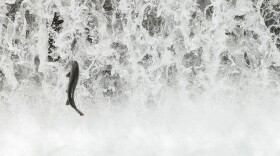Alastair Bland
Reporter | CalMattersAlastair Bland writes about water, climate, marine research, agriculture and the environment for CalMatters, a nonprofit, nonpartisan media venture explaining California policies and politics, and a JPR news partner.
-
Enlarging the dam would deliver more Sacramento River water to Central Valley farmers but a tribe could lose sacred sites and endangered salmon could lose habitat in wet years.
-
While it’s an unprecedented third year in a row for no commercially caught salmon, brief windows will be allowed for sportsfishing in California.
-
At 90% of the state historical average, the Sierra Nevada snowpack is far better than last year. But it’s nothing like the record-smashing 2023.
-
President Trump — once again — will rein in the nation’s 53-year-old law protecting waterways. At stake are seasonal streams, pools and ponds. The move is welcomed by farmers and builders.
-
President-elect Donald Trump faulted California water policies for the devastating wildfires that are burning in Los Angeles County. The fires started because of fierce winds and extremely dry conditions.
-
Some Northern California cities have been soaked with almost twice their average rainfall, while southern cities are bone-dry. This season’s huge — possibly unprecedented — disparity works in favor of the state’s water supplies.
-
Growers and cities support the Newsom administration proposal, saying it strikes a balance for uses of Delta water. But environmentalists say the “healthy rivers” rules would actually harm California’s iconic salmon.
-
Most ships discharging ballast water into California waters are inspected, but state officials have tested the water of only 16 ships. Experts say invaders like mussels are inevitable under current rules and enforcement.
-
A lot is at stake with the new Trump administration: California’s water projects, its unique authority to clean its air, federal support for offshore wind and disaster aid for wildfires.
-
Low counts of spawning salmon could mean another year without fishing. Experts say the outlook still has time to turn around.
-
Southern California growers agreed to use less water through 2026 and receive federal funds in return. But it’s not a long-term solution to the Colorado River’s water woes.
-
The governor’s building plan would adjust an environmental law known for stalling housing, dams and other projects. One environmental group said, “we have never been more disappointed in a California governor than we are with Gov. Newsom.”













